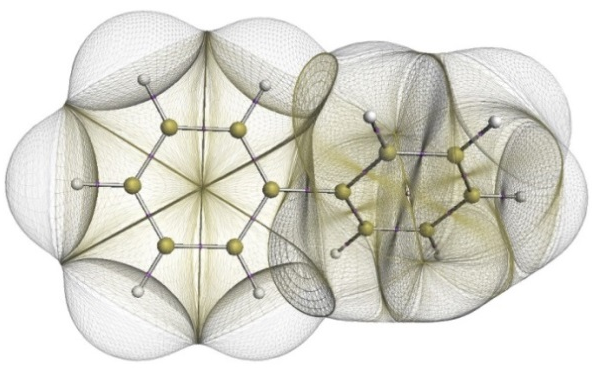Quantum Chemical Topology Group, University of Manchester, UK
E-mail: paul.popelier@manchester.ac.uk
- Obtained his undergraduate and PhD in Chemistry at the University of Antwerp(en) in Flanders.
- After compulsory military service a postdoc at McMaster University in Canada with Prof Richard Bader.
- EU-funded Marie Curie [Human Capital & Mobility (HCM)] Fellow at the University of Cambridge, Great Britain.
- Appointed lecturer at UMIST (Manchester, GB), which is a precursor of the (merged) University of Manchester.
- Currently Professor of Chemical Theory and Computation at the Univ. of Manchester.
- Activity (past and present) in the areas of chemical bonding, bio-isosterism, molecular similarity, QSAR/QSPR, VSEPR, machine learning (already from 2007 onwards), algorithms for Quantum Chemical Topology, visualisation, MD simulations, intermolecular interactions, pKa prediction, FFLUX force field, ionic liquids, crystallography, polymorphism, computation of chemical insight with Relative Energy Gradient (REG).
- Main research activity is design of machine learning potentials (FFLUX) and the (in- house) interpretational method called Relative Energy Gradient (REG).
- Chaired a Faraday Discussion Meeting on “Chemical Concepts from Quantum Mechanics”.
- Chaired a UK-QSAR meeting.
- Currently 7 PhDs and 5 postdocs in research group.
- Recipient of the Richard F.W. Bader International Prize.
- Will publish his 300th publication in 2025 with 4 books so far, with an average author count of 2.9 authors per paper, and 35 single-author publications.
- Awarded an EPSRC Established Career Fellowship.
- Awarded an ERC Advanced Grant.
Lecture 45: Paul Popelier
The Relative Energy Gradient (REG) Method or
How to Compute Chemical Insight
Quantum Chemical Topology Group, University of Manchester, UK
E-mail: paul.popelier@manchester.ac.uk
Much chemical insight ultimately comes down to finding out which fragment of a total system behaves like the total system. What is needed is a geometrical change exposing a chemical phenomenon (e.g. rotation barrier) at hand thereby generating an energy profile governed by a control coordinate.
A simple example is that of the water dimer. It is said that this system is held together by a hydrogen bond, and the distance between the two waters can serve as a control coordinate. In this case the fragment consists of two atoms: H···O making up the hydrogen bond. However, from a quantum mechanical point of view, each atom in the dimer interacts with any other atom. Thus, the view that the hydrogen bond by itself governs the energetic stability of the water dimer thus needs rigorous scrutiny.
We propose a solution for this general and important problem by presenting the Relative Energy Gradient (REG) method1. This automatable and unbiased method operates on energy contributions calculated by the Interaction Quantum Atoms (IQA) method, which belongs to the real-space partitioning framework of Quantum Chemical Topology2, 3.
The REG method has been implemented4 in the in-house program REG.py5, and also in the Amsterdam Density Functional (ADF) package. REG is able to explain many chemical phenomena. To name some: the gauche effect6, the torsional barrier in biphenyl7 (which was long controversial, see Figure), the “arrow-pushing” scheme behind an enzymatic reaction (peptide hydrolysis in the HIV-1 Protease active site)8, halogen-alkane nucleophilic substitution (SN2) reactions9, and the factors controlling the nature of complementary hydrogen-bonded networks as found in nucleic acid base pairs10.

References
[1] J. C. R. Thacker and P. L. A. Popelier, Theor.Chem.Acc., 2017, 136, 86.
[2] P. L. A. Popelier, in Challenges and Advances in Computational Chemistry and Physics dedicated to "Applications of Topological Methods in Molecular Chemistry", eds. R. Chauvin, C. Lepetit, E. Alikhani and B. Silvi, Springer, Switzerland, 2016, ch. 2, pp. 23-52.
[3] P. L. A. Popelier, in The Chemical Bond - 100 years old and getting stronger, ed. M. Mingos, Springer, Switzerland, 2016, ch. 2, pp. 71-117.
[4] F. Falcioni and P. L. A. Popelier, J.Chem.Inf.Mod., 2023, 63, 4312-4327.
[5] F. Falcioni, L. J. Duarte and P. L. A. Popelier, REG.py (Version 0.1), https://github.com/popelier-group/REG).
[6] J. C. R. Thacker and P. L. A. Popelier, J.Phys.Chem.A, 2018, 122, 1439−1450.
[7] P. L. A. Popelier, P. I. Maxwell, J. C. R. Thacker and I. Alkorta, Theor.Chem.Accs., 2019, 138:12, 1-16.
[8] J. C. R. Thacker, M. A. Vincent and P. L. A. Popelier, Chem.Eur.J., 2018, 14, 11200-11210.
[9] I. Alkorta, J. C. R. Thacker and P. L. A. Popelier, J.Comp.Chem. , 2018, 39, 546–556.
[10] O. J. Backhouse, J. C. R. Thacker and P. L. A. Popelier, ChemPhysChem, 2019, 20, 555-564.


